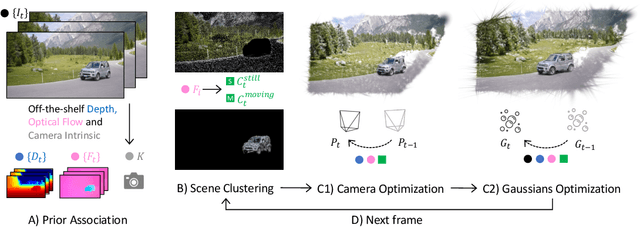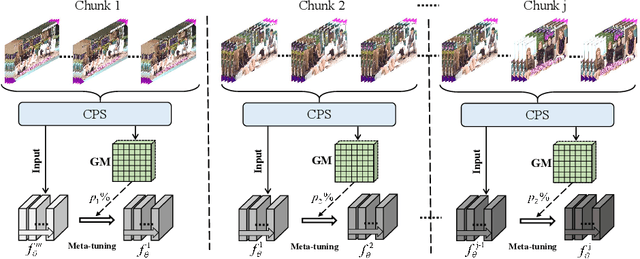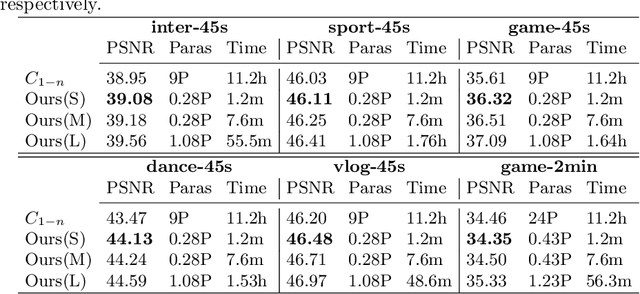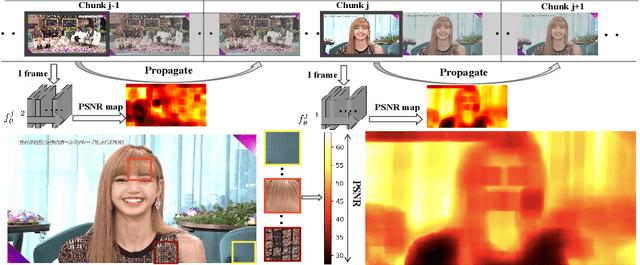Shizun Wang
Test3R: Learning to Reconstruct 3D at Test Time
Jun 16, 2025Abstract:Dense matching methods like DUSt3R regress pairwise pointmaps for 3D reconstruction. However, the reliance on pairwise prediction and the limited generalization capability inherently restrict the global geometric consistency. In this work, we introduce Test3R, a surprisingly simple test-time learning technique that significantly boosts geometric accuracy. Using image triplets ($I_1,I_2,I_3$), Test3R generates reconstructions from pairs ($I_1,I_2$) and ($I_1,I_3$). The core idea is to optimize the network at test time via a self-supervised objective: maximizing the geometric consistency between these two reconstructions relative to the common image $I_1$. This ensures the model produces cross-pair consistent outputs, regardless of the inputs. Extensive experiments demonstrate that our technique significantly outperforms previous state-of-the-art methods on the 3D reconstruction and multi-view depth estimation tasks. Moreover, it is universally applicable and nearly cost-free, making it easily applied to other models and implemented with minimal test-time training overhead and parameter footprint. Code is available at https://github.com/nopQAQ/Test3R.
PE3R: Perception-Efficient 3D Reconstruction
Mar 10, 2025Abstract:Recent advancements in 2D-to-3D perception have significantly improved the understanding of 3D scenes from 2D images. However, existing methods face critical challenges, including limited generalization across scenes, suboptimal perception accuracy, and slow reconstruction speeds. To address these limitations, we propose Perception-Efficient 3D Reconstruction (PE3R), a novel framework designed to enhance both accuracy and efficiency. PE3R employs a feed-forward architecture to enable rapid 3D semantic field reconstruction. The framework demonstrates robust zero-shot generalization across diverse scenes and objects while significantly improving reconstruction speed. Extensive experiments on 2D-to-3D open-vocabulary segmentation and 3D reconstruction validate the effectiveness and versatility of PE3R. The framework achieves a minimum 9-fold speedup in 3D semantic field reconstruction, along with substantial gains in perception accuracy and reconstruction precision, setting new benchmarks in the field. The code is publicly available at: https://github.com/hujiecpp/PE3R.
GFlow: Recovering 4D World from Monocular Video
May 28, 2024



Abstract:Reconstructing 4D scenes from video inputs is a crucial yet challenging task. Conventional methods usually rely on the assumptions of multi-view video inputs, known camera parameters, or static scenes, all of which are typically absent under in-the-wild scenarios. In this paper, we relax all these constraints and tackle a highly ambitious but practical task, which we termed as AnyV4D: we assume only one monocular video is available without any camera parameters as input, and we aim to recover the dynamic 4D world alongside the camera poses. To this end, we introduce GFlow, a new framework that utilizes only 2D priors (depth and optical flow) to lift a video (3D) to a 4D explicit representation, entailing a flow of Gaussian splatting through space and time. GFlow first clusters the scene into still and moving parts, then applies a sequential optimization process that optimizes camera poses and the dynamics of 3D Gaussian points based on 2D priors and scene clustering, ensuring fidelity among neighboring points and smooth movement across frames. Since dynamic scenes always introduce new content, we also propose a new pixel-wise densification strategy for Gaussian points to integrate new visual content. Moreover, GFlow transcends the boundaries of mere 4D reconstruction; it also enables tracking of any points across frames without the need for prior training and segments moving objects from the scene in an unsupervised way. Additionally, the camera poses of each frame can be derived from GFlow, allowing for rendering novel views of a video scene through changing camera pose. By employing the explicit representation, we may readily conduct scene-level or object-level editing as desired, underscoring its versatility and power. Visit our project website at: https://littlepure2333.github.io/GFlow
MindBridge: A Cross-Subject Brain Decoding Framework
Apr 11, 2024



Abstract:Brain decoding, a pivotal field in neuroscience, aims to reconstruct stimuli from acquired brain signals, primarily utilizing functional magnetic resonance imaging (fMRI). Currently, brain decoding is confined to a per-subject-per-model paradigm, limiting its applicability to the same individual for whom the decoding model is trained. This constraint stems from three key challenges: 1) the inherent variability in input dimensions across subjects due to differences in brain size; 2) the unique intrinsic neural patterns, influencing how different individuals perceive and process sensory information; 3) limited data availability for new subjects in real-world scenarios hampers the performance of decoding models. In this paper, we present a novel approach, MindBridge, that achieves cross-subject brain decoding by employing only one model. Our proposed framework establishes a generic paradigm capable of addressing these challenges by introducing biological-inspired aggregation function and novel cyclic fMRI reconstruction mechanism for subject-invariant representation learning. Notably, by cycle reconstruction of fMRI, MindBridge can enable novel fMRI synthesis, which also can serve as pseudo data augmentation. Within the framework, we also devise a novel reset-tuning method for adapting a pretrained model to a new subject. Experimental results demonstrate MindBridge's ability to reconstruct images for multiple subjects, which is competitive with dedicated subject-specific models. Furthermore, with limited data for a new subject, we achieve a high level of decoding accuracy, surpassing that of subject-specific models. This advancement in cross-subject brain decoding suggests promising directions for wider applications in neuroscience and indicates potential for more efficient utilization of limited fMRI data in real-world scenarios. Project page: https://littlepure2333.github.io/MindBridge
PhotoVerse: Tuning-Free Image Customization with Text-to-Image Diffusion Models
Sep 11, 2023



Abstract:Personalized text-to-image generation has emerged as a powerful and sought-after tool, empowering users to create customized images based on their specific concepts and prompts. However, existing approaches to personalization encounter multiple challenges, including long tuning times, large storage requirements, the necessity for multiple input images per identity, and limitations in preserving identity and editability. To address these obstacles, we present PhotoVerse, an innovative methodology that incorporates a dual-branch conditioning mechanism in both text and image domains, providing effective control over the image generation process. Furthermore, we introduce facial identity loss as a novel component to enhance the preservation of identity during training. Remarkably, our proposed PhotoVerse eliminates the need for test time tuning and relies solely on a single facial photo of the target identity, significantly reducing the resource cost associated with image generation. After a single training phase, our approach enables generating high-quality images within only a few seconds. Moreover, our method can produce diverse images that encompass various scenes and styles. The extensive evaluation demonstrates the superior performance of our approach, which achieves the dual objectives of preserving identity and facilitating editability. Project page: https://photoverse2d.github.io/
SwiftAvatar: Efficient Auto-Creation of Parameterized Stylized Character on Arbitrary Avatar Engines
Jan 19, 2023Abstract:The creation of a parameterized stylized character involves careful selection of numerous parameters, also known as the "avatar vectors" that can be interpreted by the avatar engine. Existing unsupervised avatar vector estimation methods that auto-create avatars for users, however, often fail to work because of the domain gap between realistic faces and stylized avatar images. To this end, we propose SwiftAvatar, a novel avatar auto-creation framework that is evidently superior to previous works. SwiftAvatar introduces dual-domain generators to create pairs of realistic faces and avatar images using shared latent codes. The latent codes can then be bridged with the avatar vectors as pairs, by performing GAN inversion on the avatar images rendered from the engine using avatar vectors. Through this way, we are able to synthesize paired data in high-quality as many as possible, consisting of avatar vectors and their corresponding realistic faces. We also propose semantic augmentation to improve the diversity of synthesis. Finally, a light-weight avatar vector estimator is trained on the synthetic pairs to implement efficient auto-creation. Our experiments demonstrate the effectiveness and efficiency of SwiftAvatar on two different avatar engines. The superiority and advantageous flexibility of SwiftAvatar are also verified in both subjective and objective evaluations.
Efficient Meta-Tuning for Content-aware Neural Video Delivery
Jul 20, 2022



Abstract:Recently, Deep Neural Networks (DNNs) are utilized to reduce the bandwidth and improve the quality of Internet video delivery. Existing methods train corresponding content-aware super-resolution (SR) model for each video chunk on the server, and stream low-resolution (LR) video chunks along with SR models to the client. Although they achieve promising results, the huge computational cost of network training limits their practical applications. In this paper, we present a method named Efficient Meta-Tuning (EMT) to reduce the computational cost. Instead of training from scratch, EMT adapts a meta-learned model to the first chunk of the input video. As for the following chunks, it fine-tunes the partial parameters selected by gradient masking of previous adapted model. In order to achieve further speedup for EMT, we propose a novel sampling strategy to extract the most challenging patches from video frames. The proposed strategy is highly efficient and brings negligible additional cost. Our method significantly reduces the computational cost and achieves even better performance, paving the way for applying neural video delivery techniques to practical applications. We conduct extensive experiments based on various efficient SR architectures, including ESPCN, SRCNN, FSRCNN and EDSR-1, demonstrating the generalization ability of our work. The code is released at \url{https://github.com/Neural-video-delivery/EMT-Pytorch-ECCV2022}.
Adaptive Patch Exiting for Scalable Single Image Super-Resolution
Mar 22, 2022



Abstract:Since the future of computing is heterogeneous, scalability is a crucial problem for single image super-resolution. Recent works try to train one network, which can be deployed on platforms with different capacities. However, they rely on the pixel-wise sparse convolution, which is not hardware-friendly and achieves limited practical speedup. As image can be divided into patches, which have various restoration difficulties, we present a scalable method based on Adaptive Patch Exiting (APE) to achieve more practical speedup. Specifically, we propose to train a regressor to predict the incremental capacity of each layer for the patch. Once the incremental capacity is below the threshold, the patch can exit at the specific layer. Our method can easily adjust the trade-off between performance and efficiency by changing the threshold of incremental capacity. Furthermore, we propose a novel strategy to enable the network training of our method. We conduct extensive experiments across various backbones, datasets and scaling factors to demonstrate the advantages of our method. Code will be released.
SamplingAug: On the Importance of Patch Sampling Augmentation for Single Image Super-Resolution
Nov 30, 2021Abstract:With the development of Deep Neural Networks (DNNs), plenty of methods based on DNNs have been proposed for Single Image Super-Resolution (SISR). However, existing methods mostly train the DNNs on uniformly sampled LR-HR patch pairs, which makes them fail to fully exploit informative patches within the image. In this paper, we present a simple yet effective data augmentation method. We first devise a heuristic metric to evaluate the informative importance of each patch pair. In order to reduce the computational cost for all patch pairs, we further propose to optimize the calculation of our metric by integral image, achieving about two orders of magnitude speedup. The training patch pairs are sampled according to their informative importance with our method. Extensive experiments show our sampling augmentation can consistently improve the convergence and boost the performance of various SISR architectures, including EDSR, RCAN, RDN, SRCNN and ESPCN across different scaling factors (x2, x3, x4). Code is available at https://github.com/littlepure2333/SamplingAug
Overfitting the Data: Compact Neural Video Delivery via Content-aware Feature Modulation
Aug 18, 2021



Abstract:Internet video delivery has undergone a tremendous explosion of growth over the past few years. However, the quality of video delivery system greatly depends on the Internet bandwidth. Deep Neural Networks (DNNs) are utilized to improve the quality of video delivery recently. These methods divide a video into chunks, and stream LR video chunks and corresponding content-aware models to the client. The client runs the inference of models to super-resolve the LR chunks. Consequently, a large number of models are streamed in order to deliver a video. In this paper, we first carefully study the relation between models of different chunks, then we tactfully design a joint training framework along with the Content-aware Feature Modulation (CaFM) layer to compress these models for neural video delivery. {\bf With our method, each video chunk only requires less than $1\% $ of original parameters to be streamed, achieving even better SR performance.} We conduct extensive experiments across various SR backbones, video time length, and scaling factors to demonstrate the advantages of our method. Besides, our method can be also viewed as a new approach of video coding. Our primary experiments achieve better video quality compared with the commercial H.264 and H.265 standard under the same storage cost, showing the great potential of the proposed method. Code is available at:\url{https://github.com/Neural-video-delivery/CaFM-Pytorch-ICCV2021}
 Add to Chrome
Add to Chrome Add to Firefox
Add to Firefox Add to Edge
Add to Edge